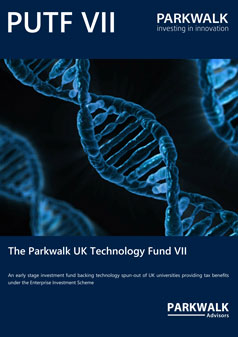|
We are delighted to announce that the University of Cambridge Enterprise Fund III has closed an investment in Silicon Microgravity, a......
|
|
|||||
 |
|
|||||
|
|||||
|
Dear , Silicon MicroGravity (“SMG”) is a spinout company from Cambridge University. The Company has developed a high performance MEMS accelerometer with a projected resolution of approximately one billionth of the Earth’s gravity, while allowing for measurement over a 180 dB dynamic range. SMG is a collaboration with the energy company, BP, which has been funding the development of the technology for nearly six years. SMG has been launched with initial venture capital funding of £2m from VCs in London and Cambridge together with grant funding from the UK Government. First Market Application - the Oil and Gas Sector Of particular interest to oil companies is the use of sensors which are small and robust enough to be sent deep into boreholes to measure gravity. The sensors need to measure gravity at a sufficient sensitivity to distinguish between oil and water. Once the location of the water is established, reservoir engineers can take action to mitigate the potentially damaging results of water reaching a production well. The company estimates that this technology could improve yields on major conventional reservoirs by 1% to 2%, representing an increase in revenue per major reservoir of over one billion dollars. The Company estimates that the total addressable market for a gravity borehole arrays is 1,000 surveys a year at a price per survey of £150,000, inferring a market potential of £150m a year. Next Technology Opportunity - a high performance rate gyro Gyroscopes have significant application in the oil and gas sector and enhance the performance of gravity sensors by enabling highly accurate positioning. However, this technology has much wider applications in the navigation, guidance, and stabilization or directing of many intelligent systems for commercial, industrial, and military applications. The underlying principles of the technology are based on resonant and mode-localized sensing to enable high-accuracy, low-frequency measurements of inertial forces. Performance levels beyond those reachable by conventional capacitive or optical sensing approaches are now accessible in MEMS inertial sensors. This unique approach to force transduction in MEMS provides exceptional parametric sensitivity that is combined with low-noise measurement techniques developed at Cambridge University, with first-order cancellation of environmental drift to address high accuracy measurements. The MEMS implementation enables access to locations not conventionally addressable by gravity sensor technology, low-frequency seismometry and inertial navigation (e.g., pedestrian or automobile navigation systems and borehole positioning) and offers the potential for substantial gains in cost, power dissipation and form factor compared to conventionally machined devices. Management Ashwin Seshia, CSO, received his BTech in Engineering Physics in 1996 from IIT Bombay, MS and PhD degrees in Electrical Engineering and Computer Sciences from the University of California, Berkeley in 1999 and 2002 respectively, and an MA from the University of Cambridge in 2008. During his time at the University of California, Berkeley, he was affiliated with the Berkeley Sensor & Actuator Center. He joined the faculty of the Engineering Department at the University of Cambridge in October 2002 where he is presently a Reader in Microsystems Technology and a Fellow of Queens' College. He is a senior member of the Institute of Electrical and Electronics Engineers (IEEE) and was appointed Fellow of the ERA Foundation in 2008. Francis Neill, Director, experienced manager of private equity backed companies with a proven track record of developing award winning companies and delivering exceptional returns for investors. He was the CEO of EV which he grew from revenues of under £1m to £22m over 5 years and has a strong background in the oil and gas sector, developing his career at Schlumberger, Aker Solutions and Expro. Roger Howe is the William E. Ayer Professor in the Department of Electrical Engineering at Stanford University, as well as the Faculty Director of the Stanford Nanofabrication Facility. He earned a B.S. degree in physics from Harvey Mudd College, Claremont, California and an M.S. and Ph.D. in electrical engineering from the University of California, Berkeley in 1981 and 1984. After faculty positions at Carnegie-Mellon University in 1984-1985 and the Massachusetts Institute of Technology from 1985-1987, he returned to Berkeley where he was a Professor until 2005. He is an adviser to the Board of the Company. Paul Vickery, Executive Chairman, has a background in venture capital and as an entrepreneur. He is the Founder of three university spinouts from Oxford University, Imperial College and Surrey University. As an investor he has advised NESTA on venture capital opportunities, was a Director of 3i plc. and led 3i's activities in Japan as Senior Managing Director. He has a BSc in Production Engineering and a Diploma in Japanese Business Studies. Kevin Dodds, based in Houston, has over thirty years of experience within the oil and gas industry as a geophysicist. This includes 20 years in field, global and engineering oversight roles within Schlumberger headquarters responsible for geophysical borehole technologies being developed in France, Japan and Houston. He developed and managed the geophysical research capability in CSIRO (Australian national research labs) and Curtin University, Perth where he is an adjunct professor. More recently he has had a senior role in BP, Houston and is an adviser to the Board of SMG. The Investment Case The company’s technology represents a major development in this highly strategic sector, and although the oil and gas market is clearly subject to price cyclicality, the company is targeting applications of significant potential value to its future clients. The company will now focus on delivering a robust commercialisation plan which, based on our past experience of working with key members of this team, we believe it will do most effectively. |
||
|
|||||
|
|||||
|
|||||
|
||
|
|||||



